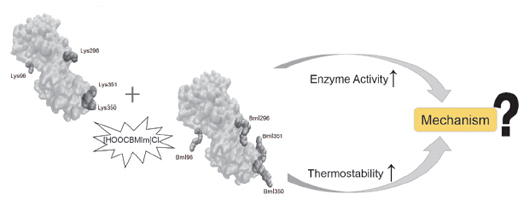| [1] Mendes, A. A.; Oliveira, P. C.; de Castro, H. F. J. Mol. Catal. B-Enzym. 2012, 78, 119.
[2] Guncheva, M.; Zhiryakova, D. J. Mol. Catal. B-Enzym. 2011, 68, 1.
[3] Fernandez, L. R. J. Mol. Catal. B-Enzym. 2010, 62, 197.
[4] Jia, R.; Hu Y.; Liu, L.; Jiang, L.; Zou, B.; Huang, H. ACS Catal. 2013, 3, 1976.
[5] Jia, R.; Hu, Y.; Liu, L.; Jiang, L.; Huang, H. Org. Biomol. Chem. 2013, 11, 7192.
[6] Malde, A. K.; Zuo, L.; Breeze, M.; Stroet, M.; Poger, D.; Nair, P. C.; Oostenbrink, C.; Mark, A. E. J. Chem. Theory Comput. 2011, 7, 4026.
[7] Jia, Y.-G.; Zhang, Y.; Zhang, H.-M.; Huang, H.; Zhang, L.-J.; Hu, Y. L. N. E. E. 2015, 333, 365.
[8] Hess, B.; Kutzner, C.; van der Spoel, D.; Lindahl, E. J. Chem. Theory Comput. 2008, 4, 435.
[9] Pronk, S.; Pall, S.; Schulz, R.; Larsson, P.; Bjelkmar, P.; Apostolov, R.; Shirts, M. R.; Smith, J. C.; Kasson, P. M.; van der Spoel, D.; Hess, B.; Lindahl, E. Bioinformatics 2013, 29, 845.
[10] Oostenbrink, C.; Soares, T. A.; van der Vegt, N. F.; van Gunsteren, W. F. Eur. Biophys. J. Biophys. 2005, 34, 273.
[11] Berendsen, H.; Postma, J.; Van, Gunsteren, W.; Hermans, J. Intermolecular Forces 1981, 11, 331.
[12] Bussi, G.; Donadio, D.; Parrinello, M. J. Chem. Phys. 2007, 126, 14101.
[13] Parrinello, M.; Rahman, A. J. Appl. Phys. 1981, 52, 7182.
[14] Ryckaert, J. P.; Ciccotti, G.; Berendsen, H. J. C. J. Comput. Phys. 1977, 23, 327.
[15] DeLano, W. L. The PyMOL Molecular Graphics System, DeLano Scientific, San Carlos, CA, USA, 2002.
[16] Hermoso, J.; Pignol, D.; Kerfelec, B.; Crenon, I.; Chapus, C.; Fontecilla-Camps, J. C. J. Biol. Chem. 1996, 271, 18007.
[17] Dang, L.; Li, M. J. Shaanxi College of Tradit. Chin. Med. 2003, 26, 60. (党琳, 李明, 陕西中医院学院学报, 2003, 26, 60.)
[18] Wolynes, P. G.; Onuchic, J. N.; Thirumalai, D. Science 1995, 267, 1619.
[19] Dill, K. A.; Ozkan, S. B.; Shell, M. S.; Weikl, T. R. Annu. Rev. Biophys. 2008, 37, 289.
[20] Sun, H.; Jiang, Y.-J.; Yu, Q.-S.; Luo, C.-C.; Zou, J.-W. Biochem. Biophys. Res. Commun. 2008, 377, 962.
[21] Fujiwara, R.; Nakajima, M.; Yamamoto, T.; Nagao, H.; Yokoi, T.; Drug Metab. Pharmacok. 2009, 24, 235.
[22] Alcaraz, L. A.; Del, Alamo, M.; Barrera, F. N.; Mateu, M. G.; Neira, J. L. Biophys. J. 2007, 93, 1264.
[23] Li, X.-J.; Zhang, C.; Li, S.; Huang, H.; Hu, Y. Ind. Eng. Chem. Res. 2015, 54, 8072.
[24] Yang, C.; Lu, D.; Liu, Z. Biochemistry 2011, 50, 2585.
[25] Longo, M. A.; Combes, D. J. Biotechnol. 1997, 58, 21.
[26] Mogharrab, N.; Ghourchian, H.; Amininasab, M. Biophys. J. 2007, 92, 1192.
[27] Hassani, L. J. Mol. Catal. B-Enzym. 2012, 80, 15.
[28] Gribenko, A. V.; Patel, M. M.; Liu, J.; McCallum, S. A.; Wang, C. Makhatadze, G. I. P. Natl. Acad. Sci. 2009, 106, 2601.
[29] Shao, Q. J. Chem. Phys. 2013, 139, 115102.
[30] Brzozowski, A.; Derewenda, U.; Derewenda, Z.; Dodson, G.; Lawson, D.; Turkenburg, J.; Bjorkling, F.; Huge-Jensen, B.; Patkar, S.; Thim, L. Nature 1991, 351, 491.
[31] Derewenda, U.; Brzozowski, A. M.; Lawson, D. M.; Derewenda, Z. S. Biochemistry 1992, 31, 1532.
[32] Copeland, R. A. Enzymes: A Practical Introduction to Structure, Mechanism, and Data Analysis, New York, 2004, p. 309. |
